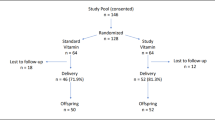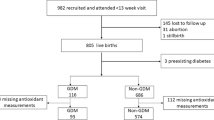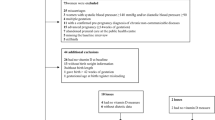Abstract
Objective: It has been known that maternal oxidative stress during pregnancy plays an important role in fetal growth. However, the association between antioxidant vitamin levels and birth outcomes is not conclusive. We investigated the relationship between maternal serum levels of vitamins C and E during the second trimester and birth weight and length.
Design: Prospective cohort study.
Setting: Outpatient-clinic of obstetrics, Ewha Womans University Hospital, South Korea.
Subjects and methods: The study subjects were 239 healthy, pregnant women who visited an obstetric clinic for antenatal care, and their singleton live births, in Seoul, Korea, between August 2001 and March 2003. We measured the levels of vitamins C and E in maternal serum during the period 24–28 gestational weeks. Each woman was interviewed for dietary intake by trained interviewers during the second trimester.
Results: The serum concentration of maternal vitamin C during the second trimester was significantly associated with birth weight and length in the group of full-term deliveries. An increase of 1 μg/ml in the serum vitamin C level increased the birth weight by 27.2 g and the birth length by 0.17 cm. When we considered the levels of vitamins C and E together in the relationship with birth weight and length, we found that the heaviest birth weight and the longest birth length belonged to the group of upper vitamin C/upper vitamin E. However, dietary intake estimated by 24-h recall method was not a predictor of the levels of serum vitamins C and E.
Conclusion: We found that maternal serum vitamin C levels during the second trimester were positively correlated with birth weight and length in full-term babies. We also found that birth weight and length were highest when the levels of both vitamins C and E were high. Our results indicate the importance of antioxidant nutrient balance for pregnant women who are exposed to various oxidants through food, drinking water, or inhaled air.
This is a preview of subscription content, access via your institution
Access options
Subscribe to this journal
Receive 12 print issues and online access
$259.00 per year
only $21.58 per issue
Buy this article
- Purchase on Springer Link
- Instant access to full article PDF
Prices may be subject to local taxes which are calculated during checkout

Similar content being viewed by others
References
Barker DJ, Gluckman PD, Godfrey KM, Harding JE, Owens JA & Robinson JS (1993): Fetal nutrition and cardiovascular disease in adult life. Lancet 341, 938–941.
Baydas G, Karatas F, Gursu MF, Bozkurt HA, Ilhan N, Yasar A & Canatan H (2002): Antioxidant vitamin levels in term and preterm infants and their relation to maternal vitamin status. Arch. Med. Res. 33, 276–280.
Bieri MA, Tolliver TJ & Catignani GL (1979): Simultaneous determination of α-tocopherol and retinol in plasma and red cells by high pressure lipid chromatography. Am. J. Clin. Nutr. 32, 2143–2149.
Blanchard J, Tozer TN & Rowland M (1997): Pharmacokinetic perspectives on megadoses of ascorbic acid. Am. J. Clin. Nutr. 66, 1165–1171.
Bolisetty S, Naidoo D, Lui K, Koh TH, Watson D & Whitehall J (2002): Antenatal supplementation of antioxidant vitamins to reduce the oxidative stress at delivery—a pilot study. Early Hum. Develop. 67, 47–53.
Cederberg J, Siman M & Eriksson UJ (2001): Combined treatment with vitamin E and vitamin D decreases oxidative stress and improves fetal outcome in experimental diabetic pregnancy. Pediatr. Res. 49, 755–762.
Chappell LC, Seed PT, Kelly FJ, Briley A, Hunt BJ, Charnock-Jones DS, Mallet A & Poston L (2002): Vitamin C and E supplementation in women at risk of preeclampsia is associated with changes in indices of oxidative stress and placental function. Am. J. Obstet. Gynecol. 187, 777–784.
Di Mascio P, Murphy ME & Sies H (1991): Antioxidant defense systems: the role of carotenoids, tocopherols, and thiols. Am. J. Clin. Nutr. 53 (Suppl 1), S194–S200.
Dison PJ, Lockitch G, Halstead AC, Pendray MR, Macnab A & Wittmann BK (1993): Influence of maternal factors on cord and neonatal plasma micronutrient levels. Am. J. Perinatol. 10, 30–35.
Fall CH, Yajnik CS, Rao S, Davies AA, Brown N & Farrant HJ (2003): Micronutrients and fetal growth. J. Nutr. 133 (Suppl 2), S1747–S1756.
Ghebremeskel K, Burns L, Burden TJ, Harbige L, Costeloe K, Powell JJ & Crawford M (1994): Vitamin A and related essential nutrients in cord blood: relationship with anthropometric measurements at birth. Early Hum. Develop. 39, 177–188.
Godfrey K, Barker DJ, Robinson S & Osmond C (1997): Maternal birthweight and diet in pregnancy in relation to the infant’s thinness at birth. Br. J. Obstet. Gynaecol. 104, 663–667.
Godfrey KM & Barker DJ (2000): Fetal nutrition and adult disease. Am. J. Clin. Nutr. 71 (Suppl 5), S1344–S1352.
Guajardo L, Beharry KD, Modanlou HD & Aranda JV (1995): Ascorbic acid concentrations in umbilical cord veins and arteries of preterm and term newborns. Biol. Neonate 68, 1–9.
Hack M & Fanaroff AA (1999): Outcomes of children of extremely low birthweight and gestational age in the 1990's. Early. Hum. Dev. 53, 193–218.
Hales CN, Barker DJ, Clark PM, Cox LJ, Fall C, Osmond C & Winter PD (1991): Fetal and infant growth and impaired glucose tolerance at age 64. BMJ 303, 1019–1022.
Hubel CA, Roberts JM, Taylor RN, Musci TJ, Rogers GM & McLaughlin MK (1989): Lipid peroxidation in pregnancy: New perspectives on preeclampsia. Am. J. Obstet. Gynecol. 161, 1025–1034.
Jagadeesan V & Prema K (1980): Plasma tocopherol and lipid levels in mothers and umbilical cord; influence on birth weight. Br. J. Obstet. Gynaecol. 87, 908–910.
Kankofer M (2001): Non-enzymatic antioxidative defence mechanisms against reactive oxygen species in bovine-retained and not-retained placenta: vitamin C and glutathione. Reprod. Domest. Anim. 36, 203–206.
Karowicz-Bilinska A, Suzin J & Sieroszewski P (2002): Evaluation of oxidative stress indices during treatment in pregnant women with intrauterine growth retardation. Med. Sci. Monit. 8, CR211–CR216.
Kharb S (2000): Vitamin E and C in preeclampsia Eur. J. Obstet. Gynecol. Reprod. Biol. 93, 37–39.
Kramer MS (2002): Why are babies getting bigger? Temporal trends in fetal growth and its determinants. J. Pediatr. 141, 538–542.
Kutnink MA, Hawkes WC, Schaus EE & Amaye ST (1987): An internal standard method for the unattended high-performance lipid chromatographic analysis of ascorbic acid in blood components. Anal. Biochem. 166, 424.
Lachili B, Hininger I, Faure H, Arnaud J, Richard MJ, Favier A & Roussel AM (2001): Increased lipid peroxidation in pregnant women after iron and vitamin C supplementation. Biol. Trace Elem. Res. 83, 103–110.
Levine M, Conry-Cantilena C, Wang Y, Welch RW, Washko PW, Dhariwal KR, Park JB, Lazarev A, Graumlich JF, King J & Cantilena LR (1996): Vitamin C pharmacokinetics in healthy volunteers: evidence for a recommended dietary allowance. Proc. Natl. Acad. Sci. USA 93, 3704–3709.
Mathews F, Yudkin P & Neil A (1999): Influence of maternal nutrition on outcome of pregnancy: prospective cohort study. BMJ 319, 339–343.
Mathews F, Yudkin P, Smith RF & Neil A (2000): Nutrient intakes during pregnancy: the influence of smoking status and age. J. Epidemiol. Community Health 54, 17–23.
Mutch L, Ashurst H & Macfarlane A (1992): Birth weight and hospital admission before the age of 2 years. Arch. Dis. Child. 67, 900–904.
Myatt L, Eis AL, Brockman DE, Kossenjans W, Greer IA & Lyall F (1997): Differential localization of superoxide dismutase isoforms in placental villous tissue of normotensive, pre-eclamptic, and intrauterine growth-restricted pregnancies. J. Histochem. Cytochem. 45, 1433–1438.
Niki E (1987): Interaction of ascorbate and alpha-tocopherol. Ann. N. Y. Acad. Sci. 498, 186–199.
Olsen J (2001): The Danish National Birth Cohort—its background, structure and aim. Scand. J. Public Health 29, 300–307.
Osmond C, Barker DJ, Winter PD, Fall CH & Simmonds SJ (1993): Early growth and death from cardiovascular disease in women. BMJ 307, 1519–1524.
Parker L (1992): Interactions among antioxidants in health and disease: vitamin E and its redox cycle. Proc. Soc. Exp. Biol. Med. 200, 271–276.
Proteggente AR, England TG, Rice-Evans CA & Halliwell B (2001): Iron supplementation and oxidative damage to DNA in healthy individuals with high plasma ascorbate. Biochem. Biophys. Res. Commun. 288, 245–251.
Rao S, Yajnik CS, Kanade A, Fall CH, Margetts BM, Jackson AA, Shier R, Joshi S, Rege S, Lubree H & Desai B (2001): Intake of micronutrient-rich foods in rural Indian mothers is associated with the size of their babies at birth: Pune Maternal Nutrition Study. J. Nutr. 131, 1217–1224.
Rose RC (1990): Ascorbic acid metabolism in protection against free radicals: a radiation model. Biochem. Biophys. Res. Commun. 169, 430–436.
Scholl TO & Stein TP (2001): Oxidant damage to DNA and pregnancy outcome. J. Matern. Fetal. Med. 10, 182–185.
Strauss RS & Dietz WH (1998): Growth and development of term children born with low birth weight: effects of genetic and environmental factors. J. Pediatr. 133, 67–72.
Tamura T, Goldenberg RL, Johnston KE, Cliver SP & Hoffman HJ (1997): Serum concentrations of zinc, folate, vitamins A and E, and proteins, and their relationship to pregnancy outcome. Acta Obstet. Gynecol. Scand. 165, 63–70.
Tappel AL (1968): Will antioxidant nutrients slow aging process? Geriatrics 23, 97–105.
The Korean Nutrition Society (2000): Recommended Dietary Allowances for Koreans (7th revision). The Korean Nutrition Society: Seoul.
The Korean Nutrition Society (2002) Can-Pro version 2.0, The Korean Nutrition Society: Seoul.
Uotila J, Tuimala R, Aarnio T, Pyykko K & Ahotupa M (1991): Lipid peroxidation products, selenium-dependent glutathione peroxidase and vitamin E in normal pregnancy. Eur. J. Obstet. Gynecol. Reprod. Biol. 42, 95–100.
van den Broek NR & Letsky EA (2000): Etiology of anemia in pregnancy in south Malawi. Am. J. Clin. Nutr. 72 (Suppl), S247–S256.
von Mandach U, Huch R & Huch A (1994): Maternal and cord serum vitamin E levels in normal and abnormal pregnancy. Int. J. Vitam. Nutr. Res. 64, 26–32.
Wang Y, Walsh SW, Guo JG & Zhang J (1991): The imbalance between thromboxane and prostacyclin in preeclampsia is associated with an imbalance between lipid peroxides and vitamin E in maternal blood. Am. J. Obstet. Gynecol. 165, 1695–1700.
Wang Y & Walsh SW (2001): Increased superoxide generation is associated with decreased superoxide dismutase activity and mRNA expression in placental trophoblast cells in pre-eclampsia. Placenta 22, 206–212.
Acknowledgements
This study was supported by the Korea Health 21 R&D project, Ministry of Health & Welfare (HMP-01-PT1-01CH15-0009). YC Hong was supported in part by the Korea Research Foundation (E00091).
Author information
Authors and Affiliations
Contributions
Guarantors: YC Hong and YJ Kim.
Contributors: YCH and YJK designed the present study. YCH was responsible for analyzing data and writing the manuscript. BEL wrote the manuscript. YJK recruited the subjects and collected data. WKK and NSC took the biochemical assay and analyzed the dietary data. EAP and HSP were involved in the design of the study and in reviewing the paper. KHL and HJH critically reviewed the manuscript.
Corresponding author
Rights and permissions
About this article
Cite this article
Lee, B., Hong, Y., Lee, K. et al. Influence of maternal serum levels of vitamins C and E during the second trimester on birth weight and length. Eur J Clin Nutr 58, 1365–1371 (2004). https://doi.org/10.1038/sj.ejcn.1601976
Received:
Revised:
Accepted:
Published:
Issue Date:
DOI: https://doi.org/10.1038/sj.ejcn.1601976
Keywords
This article is cited by
-
Maternal fruit and vegetable or vitamin C consumption during pregnancy is associated with fetal growth and infant growth up to 6 months: results from the Korean Mothers and Children’s Environmental Health (MOCEH) cohort study
Nutrition Journal (2018)
-
The Paraoxonase 1 Arylesterase Activity, Total Oxidative Stress, Nitric Oxide and Vitamin C Levels in Maternal Serum, and Their Relation to Birth Weight of Newborn
The Journal of Obstetrics and Gynecology of India (2016)
-
Maternal vitamin C deficiency during pregnancy results in transient fetal and placental growth retardation in guinea pigs
European Journal of Nutrition (2015)
-
Risk factors for macrosomia in infants born to Latina women
Journal of Perinatology (2008)



